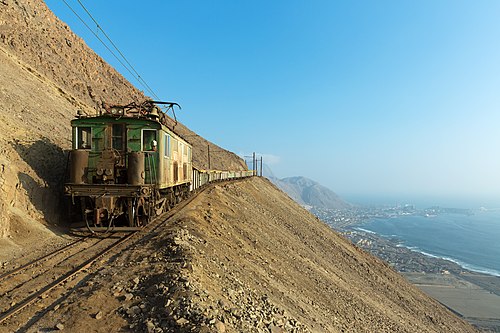Talk:Tocopilla railway
| This article is rated Start-class on Wikipedia's content assessment scale. It is of interest to the following WikiProjects: | |||||||||||||||||||||
| |||||||||||||||||||||
Pedro de Valdivia works closed 1996, according to the sign on the front gate.
Infobox needed
[edit] High above Tocopilla, an iconic Boxcab leads a train down to Reverso | |||
| Overview | |||
|---|---|---|---|
| Main region(s) | Plains of Northern Antofagasta province | ||
| Parent company | SQM | ||
| Dates of operation | 1890–2016 | ||
| Predecessor | ACN&R, TCPP, SIT | ||
| Technical | |||
| Track gauge | 3'6" | ||
| Electrification | 1500V DC | ||
| Track length | 227km | ||
| No. of tracks | single | ||
| Highest elevation | 1454m | ||
| |||
to be filled.--Oldboltonian (talk) 22:06, 1 November 2020 (UTC)
when did the boxcars retire?
[edit]4 locos including 601 and 603 still operating 2012[1]--Oldboltonian (talk) 22:06, 1 November 2020 (UTC)
Meyers
[edit]Kitson built one for ACNR in 1894. https://alchetron.com/0-6-0-0-6-0--
Kerr Stuart built one in 1906
[1] --Oldboltonian (talk) 22:39, 1 November 2020 (UTC)
References
- ^ "Model steam locomotive, Anglo-Chilean Nitrate Railway". Science Museum Group. Science Museum. Retrieved 1 November 2020.
map
[edit]Much of the rails appear in open street map. Would be good to make an overlay layer (User:J. Johnson/OSM overlay how-to) based on the IGM map at http://resmy.fortunecity.ws/fcttmapa.jpg and the Binns sketch map, and show which lines built when, electrification etc...--Oldboltonian (talk) 22:59, 1 November 2020 (UTC)
Info on 65x +++
[edit]Si tengo información acerca de la serie E650, construida por Casagrande Motori y Chesta. Casagrande consteuyo todo lo que es el frame y Chesta la electronica de potencia para el control de tracción. Buscaré la información y se la hago llegar. Lo otro, leyendo su articulo, le sugiero: - Editar el titulo "Tocopilla Nitrate Railway" ya que se confunde o puede asimilarse con la empresa salitrera "Tocopilla Nitrate & Railway" que opero como una salitrera más en el sector Toco, y no se asimila al "Ferrocarril de Tocopilla al Toco" ( FCTT) construido por la Anglo-Chilean Nitrate& Railway Co.
- El numero de curvas en el sector Tocopilla-Barriles era de 219, no 263 como dicen algunas publicaciones.
-El radio minimo de curva era de 181 feet o 55 mts.
Email from Mario Beroiza 2 Nov 2020 posted by --Oldboltonian (talk) 17:45, 2 November 2020 (UTC)
I dont see 654-656 in any pix! were they ever delivered?--Oldboltonian (talk) 18:32, 4 November 2020 (UTC)
Featured picture scheduled for POTD
[edit]Hello! This is to let editors know that File:SQM GE_289A_Boxcab_Carmelita_-_Reverso.jpg, a featured picture used in this article, has been selected as the English Wikipedia's picture of the day (POTD) for January 11, 2025. A preview of the POTD is displayed below and can be edited at Template:POTD/2025-01-11. For the greater benefit of readers, any potential improvements or maintenance that could benefit the quality of this article should be done before its scheduled appearance on the Main Page. If you have any concerns, please place a message at Wikipedia talk:Picture of the day. Thank you! — Amakuru (talk) 10:02, 9 January 2025 (UTC)

|
|
The Tocopilla railway was a mountain railway built to serve the sodium nitrate mines in the Toco area of the Antofagasta Region in Chile. With a gauge of 3 ft 6 in (1,067 mm), it ran from the port of Tocopilla on the Pacific coast up to a height of 4,902 feet (1,494 metres), with gradients up to 1 in 24. The railway was built by a joint-stock company founded in London and was designed by William Stirling of Lima, with a detailed description of the initial operation of the railway published by his brother Robert in 1900.The line was electrified in the mid-1920s and expanded in 1930 with the addition of lines serving new areas of mining. It continued operating into the 21st century, but was forced to close in 2015 when flash flooding caused numerous washouts on the electrified section of the railroad. With the declining prospects for nitrate, it was not economical for the line to be repaired. This photograph taken in 2013 shows a boxcab on the Tocopilla railway, leading a train down towards the coast. Photograph credit: David Gubler
Recently featured:
|




